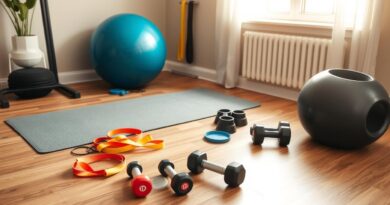Breathing Exercises for Fat Loss: Get Fit Fast
Breathing Exercises for Fat Loss may sound simple, but they can be a powerful tool in your weight loss journey. Are you tired of trying every fad diet and exercise routine without seeing results? You’re not alone. Many struggle to lose weight and get fit, but what if you could achieve your goals without hours at the gym?
Breathing techniques have been used for centuries to improve health and well-being. Recent research shows they can aid in fat loss. Adding simple breathing exercises to your daily routine lets you start your weight loss journey and see results fast.

Imagine boosting your metabolism and burning fat without drastic lifestyle changes. It’s possible, and it’s easier than you think.
Key Takeaways
- Breathing techniques can aid in fat loss
- Simple exercises can be incorporated into daily routine
- Boost metabolism and burn fat without drastic lifestyle changes
- Get fit fast with breathing exercises
- Achieve weight loss goals without hours at the gym
The Science Behind Breathing and Fat Loss
The link between breathing, oxygen, and fat loss is intricate and deeply connected to how our body utilizes energy. When you engage in a breathing exercise for weight loss, you’re not just working your lungs—you may also be enhancing your body’s ability to burn fat more efficiently.

How Oxygen Affects Metabolism
Oxygen is key to how our body uses fat for energy. Good Breathing means your body gets the oxygen it needs, which helps your metabolism work better.
The Role of Oxygen in Energy Production
Oxygen is vital for turning fat into energy. Adequate oxygen supply makes this process more efficient. This helps you lose weight.
Respiratory Quotient and Fat Burning
The respiratory quotient (RQ) shows what energy source your body uses. Respiratory workouts for weight loss can change your RQ. This might help you burn more fat.
The Fat Oxidation Process
Fat oxidation is when your body breaks down fat for energy. Good Breathing helps this process by providing enough oxygen.
Converting Fat to Energy
Doing respiratory training improves your body’s fat-to-energy conversion. This is thanks to better oxygen use and metabolism.
Research Evidence on Respiratory Training
Studies show that specific breathing methods can help with weight loss. They boost your metabolic rate and fat oxidation. Adding fat-burning breathing exercises to your routine could support your weight loss goals.
Breathing Exercises for Fat Loss: Core Principles
You need to know the basics to use breathing exercises for fat loss. These exercises can change your body in many ways, helping you lose weight by affecting how your body works.
What Makes Breathing Exercises Effective for Weight Management
Breathing exercises help with weight management in a few ways. They affect how much oxygen you use and your metabolic rate. They also help control your body’s automatic functions.
Oxygen Consumption and Metabolic Rate
Breathing exercises can help you use more oxygen, which can cause your body to burn more calories, even when you’re not moving. This is key for weight loss and keeping your metabolism healthy.
Autonomic Nervous System Regulation
Breathing exercises also affect the autonomic nervous system, which controls things like heart rate and digestion. By changing this system, breathing exercises can lower stress and improve your body’s functions, which can help with weight management.
Common Misconceptions About Breathing and Weight Loss
There are many wrong ideas about breathing exercises and weight loss. It’s important to know what’s true and what’s not. You should have realistic hopes for how these exercises will help you.
Separating Facts from Marketing Claims
Many products promise quick weight loss with breathing exercises. But you should be careful. Look for real science behind any claims before trying them.
Realistic Expectations for Results
Breathing exercises can be helpful for weight loss, but they’re not the only thing you need. You also need a healthy diet and regular exercise. Here are some essential things to remember:
- Breathing exercises alone might not lead to significant weight loss.
- Using breathing exercises with other lifestyle changes can make them more effective.
- Being consistent is essential; you need to practice regularly to see results.

Knowing how breathing exercises work and having realistic hopes can help you use them effectively in your weight loss journey.
Benefits of Respiratory Training Beyond Fat Loss
Breathing exercise weight loss routines do more than just help you shed fat—they also boost your physical and mental health. By using targeted breathing techniques to burn calories, you enhance overall well-being and support a healthier lifestyle.

Stress Reduction and Cortisol Management
Respiratory training is excellent for reducing stress and managing cortisol. Controlled Breathing activates the parasympathetic nervous system, calms the mind and body, and lowers cortisol levels.
Improved Lung Capacity and Oxygen Utilization
It also boosts lung capacity and oxygen use. Strengthening your diaphragm lets you breathe deeper, which means your body gets more oxygen, increasing your energy and performance.
Enhanced Recovery Between Workouts
Respiratory training helps you recover faster between workouts. It improves oxygen use and reduces lactic acid, allowing you to train harder and more often, leading to better fitness.
In short, respiratory training is a powerful tool. It offers many benefits beyond fat loss. By adding breathing techniques for burning calories to your routine, you’ll see less stress, better lung function, and faster recovery, leading to a healthier, more balanced life.
Diaphragmatic Breathing Techniques
Diaphragmatic Breathing is key to better Breathing and fat loss. It helps your body burn fat more efficiently.

Belly Breathing Fundamentals
Belly breathing, or diaphragmatic Breathing, uses your diaphragm. This muscle is between your chest and belly. You must know how to place your hands and body to do it right.
Proper Hand Placement and Body Position
First, put one hand on your chest and the other on your belly. When you breathe in, your belly should go up, while your chest should stay still. This will ensure that you’re using your diaphragm correctly.
Progression from Lying to Standing Practice
Start by lying on your back to practice belly Breathing. Then, move to sitting and finally standing. This will strengthen your diaphragm and improve your Breathing.
Progressive Diaphragmatic Training
For better Breathing, try progressive training. This means doing longer and harder breathing exercises over time. Start with short sessions and make them longer as you get stronger.
| Training Day | Breathing Exercise Duration | Intensity Level |
| 1-3 | 5 minutes | Low |
| 4-7 | 10 minutes | Moderate |
| 8-14 | 15 minutes | High |
Incorporating Diaphragmatic Breathing Into Daily Life
You can use diaphragmatic Breathing in your daily life. Do it while walking or doing chores. It helps with fat loss, reduces stress, and improves your health.
By using these breathing techniques every day, you can boost your fat loss efforts and live a healthier, more balanced life.
High-Intensity Breathing Exercises for Maximum Fat Burn
Adding high-intensity Breathing to your workout helps you lose fat. These exercises make your heart beat faster, improve oxygen flow, and kickstart your metabolism. This leads to better fat loss.

Breath of Fire Technique
The Breath of Fire is an intense breathing exercise. It involves quick, shallow breaths through the nose. It’s great for detoxifying and boosting lung function.
Step-by-Step Instructions
To do Breath of Fire, sit up straight first. Take a few deep breaths, then start quick, shallow Breathing. Focus on passive inhalation and active exhalation, letting your belly move with your breath.
Optimal Duration and Frequency
Start with 1-2 minutes of Breath of Fire and work up to 5-10 minutes. For best results, do it 2-3 times a day.
Bhastrika Pranayama (Fast-Paced Breathing)
Bhastrika Pranayama, or Bellows Breath, is another excellent exercise. It involves deep, forceful breaths followed by a brief pause, which boosts the nervous system and burns fat.
Proper Technique and Form
To practice Bhastrika Pranayama, sit up straight with your hands on your knees. Breathe in deeply, then exhale strongly through your nose. Repeat this a few times before holding your breath for a bit.
Progressive Intensity Levels
Begin with three cycles of Bhastrika Pranayama and increase to 10 cycles as you get better. To increase the intensity, you can also strengthen your exhalations.
Safety Considerations for Intense Breathing Exercises
High-intensity breathing exercises are usually safe, but be careful. Avoid these exercises if you feel dizzy or lightheaded. If you have health issues, talk to a doctor before starting.
| Breathing Technique | Duration | Frequency |
| Breath of Fire | 1-10 minutes | 2-3 times a day |
| Bhastrika Pranayama | 3-10 cycles | Once or twice a day |
Rhythmic Breathing Patterns to Boost Calorie Expenditure
Rhythmic Breathing is a powerful tool to increase calorie burn and boost fitness. Adding specific patterns to your daily routine can boost your metabolism. This helps support your weight loss goals.
Different rhythmic breathing techniques can stimulate various physiological responses, which can enhance calorie expenditure. Let’s explore some practical methods for your fitness regimen.
Box Breathing for Fat Loss
Box breathing, also known as square Breathing, involves breathing in for four counts, holding for four counts, exhaling for four counts, and holding again for four counts. This creates a “box” shape with your breath.
Benefits: Reduces stress, improves focus, and can contribute to a more efficient metabolic rate.
4-7-8 Breathing Method
The breathing 478 technique, also known as the 4-7-8 breathing method or “relaxation breath,” involves inhaling through the nose for four counts, holding for seven counts, and exhaling through the mouth for eight counts. This powerful method can help reduce anxiety, calm the nervous system, and promote deep relaxation.
Effectiveness: It can help reduce cortisol levels, potentially aiding in fat loss.
Alternate Nostril Breathing
Alternate nostril breathing is a yogic technique that involves closing one nostril and breathing in through the other, then switching to exhale through the opposite nostril. This balances the breath and can have a calming effect on the nervous system.
Advantages: Improves respiratory function and can enhance overall well-being.
| Breathing Technique | Primary Benefits | Calorie Expenditure Impact |
| Box Breathing | Reduces stress, improves focus | Moderate |
| 4-7-8 Breathing | Reduces anxiety, promotes relaxation | High |
| Alternate Nostril Breathing | Balances breath, improves respiratory function | Moderate |
Incorporating these rhythmic breathing patterns into your daily routine can potentially enhance your calorie expenditure, supporting your overall fitness goals.
Combining Breathing Exercises With Physical Activity
Linking Breathing with exercise boosts workouts and fat loss. This method works for walking, strength training, and cardio.
Breath-Focused Walking Routines
Adding breathing exercises to your walks is easy and effective. It makes your walks better.
Synchronizing Steps with Breath
Match your breath with your steps. Inhale for four steps, then exhale for four. This keeps your pace steady.
Intensity Progression Guidelines
To increase the intensity, change your breathing pattern. Try inhaling for three steps and exhaling for three. Or, use a faster pattern, like inhaling for two and exhaling for two.
Respiratory Training During Strength Workouts
Breathing helps in strength training, too. It lets you lift more and recover faster.
Breathing Patterns for Lifting
Exhale when you exert and inhale when you relax. This strengthens your core and keeps you stable.
Recovery Breathing Between Sets
Use deep Breathing between sets to recover. It cuts down on fatigue and boosts performance.
Optimizing Breathing During Cardio Sessions
Sync your Breathing with cardio activities like running or cycling. A steady breathing pattern improves endurance.
Combining Breathing with exercise elevates your fitness. Try various methods to see what suits you best.
Creating Your Fat-Burning Breathing Exercise Routine
Creating a fat-burning breathing routine can boost your weight loss. Tailor your exercises to fit your fitness level and goals. This way, you get the most out of your practice.
Beginner’s 7-Day Plan
Beginners should start with a solid foundation in breathing exercises. This 7-day plan introduces basic techniques. These help with fat loss and improve Breathing.
Daily Practice Schedule
Start with 5-10 minutes of diaphragmatic Breathing each day. Increase the time as you improve.
Expected Initial Adaptations
You’ll likely feel better and more energetic in the first few days. As you adapt, you’ll see better endurance in physical activities.
Intermediate 14-Day Program
After mastering the basics, move to more advanced techniques. This 14-day Program combines different breathing methods to boost fat loss.
Combining Multiple Techniques
Switch between Breath of Fire and 4-7-8 Breathing for a varied routine. This mix can speed up your metabolism and burn more fat.
Progression Markers
Monitor your Breathing, energy, and physical performance to keep track of your progress. Adjust your routine to keep challenging yourself.
Advanced 30-Day Respiratory Training Schedule
A 30-day advanced program offers a bigger challenge for the more experienced. It includes complex Breathing and longer sessions to test your Breathing thoroughly.
Overcoming Challenges and Measuring Success
Starting your breathing exercise journey comes with challenges. It’s essential to keep practising and track your progress. This helps you reach your fat loss goals through breathing exercises.
Common Obstacles in Breathing Practice
Many people face obstacles when starting breathing exercises. Two significant challenges are keeping up with practice and feeling uncomfortable.
Maintaining Consistency
To stay consistent, set realistic goals. Pick a time each day for your breathing exercises. Even a few minutes a day is better than long sessions a few times a week.
Dealing with Discomfort
Feeling uncomfortable is normal when starting breathing exercises. Focus on your technique. Slowly increase the length and intensity of your practice to reduce discomfort.
Tracking Physiological Improvements
Tracking your progress can motivate you. Two essential things to watch are your resting heart rate and how long you can breathe.
Resting Heart Rate Changes
A lower resting heart rate means better heart health. Tracking this can show how your breathing practice is improving your health.
Breath Hold Capacity
Being able to hold your breath longer shows better lung function. Try to time how long you can breathe after a few minutes of relaxed Breathing.
Tools and Apps for Monitoring Progress
Using the right tools can improve your Breathing practice. Many apps and devices track your progress, guide you, and show how your body is improving. Some popular choices include breath-tracking apps and wearable devices that monitor heart rate and more.
Conclusion: Breathing Your Way to a Healthier You
Do you know how breathing exercises can help you lose fat and feel better? You can speed up your metabolism by using diaphragmatic Breathing, high-intensity exercises, and rhythmic patterns. This also helps reduce stress and improves your health.
Remember to start slow and keep it up as you work towards a healthier life. Start with simple belly breathing and then move to more complex techniques. Regular practice will help you achieve a healthier balance in your life.
Adding breathing exercises to your daily routine takes a big step towards a healthier lifestyle. So, take a deep breath and begin your journey today. You can change your health and well-being one breath at a time.
FAQ
What are breathing exercises for fat loss?
Breathing exercises for fat loss help you burn fat. They improve your Breathing, increase oxygen use, and boost your metabolism.
How do breathing exercises aid in weight loss?
They help by improving oxygen use, controlling the nervous system, and speeding up metabolism, which leads to more fat-burning.
Are there specific breathing techniques for fat loss?
Yes, there are. Diaphragmatic Breathing, Breathing of fire, Bhastrika Pranayama, box breathing, 4-7-8 Breathing, and alternate nostril breathing are good for fat loss if done regularly.
Can breathing exercises alone lead to significant weight loss?
Breathing exercises can help with weight loss. But they work best when you also eat healthy and exercise regularly.
How often should I practice breathing exercises for fat loss?
Practice daily at the same time. It’s best to add them to your workout routine.
Are there any safety considerations for high-intensity breathing exercises?
Yes, start slow and listen to your body. Stop if you feel pain or discomfort. Always check with a doctor before starting new exercises.
Can I combine breathing exercises with other forms of exercise?
Mixing breathing exercises with walking, strength training, or cardio can make them more effective.
How do I track the progress of my breathing exercises?
Track by watching your resting heart rate, breath hold, and how comfortable you feel during exercise. Use apps or tools for tracking.
What are some common obstacles in breathing practice, and how can I overcome them?
Common issues are staying consistent and feeling uncomfortable. Start small, increase slowly, and practice simultaneously every day.
Can respiratory training help with stress reduction?
Yes, it can. Respiratory training helps control your nervous system and promotes relaxation. This improves your overall well-being.
Read More





